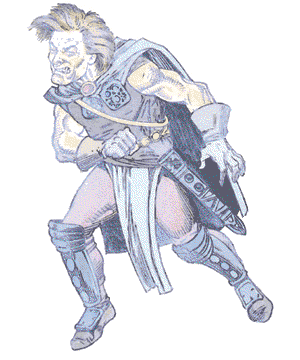| Climate/Terrain: | Any/Land |

|
| Frequency: | Very rare | |
| Organization: | Solitary | |
| Activity Cycle: | Any | |
| Diet: | Nil | |
| Intelligence: | Nil | |
| Treasure: | Nil | |
| Alignment: | Neutral | |
| No. Appearing: | 1 | |
| Armor Class: | Nil | |
| Movement: | 9 | |
| Hit Dice: | Nil | |
| THAC0: | Nil | |
| No. of Attacks: | Nil | |
| Damage/Attack: | Nil | |
| Special Attacks: | Fear | |
| Special Defenses: | Nil | |
| Magic Resistance: | See below | |
| Size: | Varies, usually M | |
| Morale: | Nil | |
| XP Value: | Nil |
Phantoms are images left behind by particularly strong death traumas. A phantom is like a three-dimensional movie image filmed at the time of death, in the place where it died.
The standard phantom may appear as almost anything. It often appears as the character who experienced the trauma-a transparent image re-enacting the death scene. Alternatively, it could represent whatever was foremost in the victim's mind at the time of death; an attacker, or some goal left unachieved. Phantoms are experienced in faded colors, by all senses.
Combat: It is difficult to fight phantoms, since they are merely images and have no power to directly cause harm. They cannot themselves be harmed. Swinging weapons or casting spells into the area of the image does not interfere with the projection, and they cannot be reasoned with. A phantom is not intelligent and does not exist for any real reason; tracking down its killer or completing its quest will not get rid of a phantom.
Phantoms are often mistaken for ghosts, haunts, or groaning spirits, but they can not be turned as undead. Only a priest spell remove curse, cast at 12th level, can dispel a phantom.
Although a phantom cannot directly do any actual harm, it is the very essence of magic and calls up a superstitious awe in anyone who sees one. The enchantment is such that the phantom affects both the mind and the senses of the observer. Creatures without minds (such as undead) are immune to the effects of phantoms, as are those rare beings who are somehow unable to experience them (since the phantom is present to all senses, blindness is not normally protection against one).
Characters witnessing a phantom must roll a successful saving throw vs. death magic, with a -2 penalty, or immediately panic and run away as per the effects of a fear spell. Particularly vivid phantoms may require those who fail their saving throw to make a system shock roll, with a +10 bonus to the roll. Failure results in death for the unfortunate victim. Such a character can be raised normally, however.
There are other difficulties with the fear effect; the cause of the phantom's death might still be around. Even after centuries, traps and undead monsters can be just as effective and deadly, and running away in panic is usually not the best defense.
Of course, a phantom may provide characters with important information, either forewarning careful characters of an upcoming danger, or finding a lost and treasured object.
There is a slight chance that a character's death may engender a phantom. This chance should be minuscule to nonexistent for 0-level or very low-level characters, or for those who were expecting to die-those dying of natural causes or in war. However, characters of 4th level or above, dying suddenly or by surprise might have a 1-2% chance of becoming phantoms. If those characters were on an important mission or were subject to geas or quest spells, this chance might rise to 5-6 percent. The percentage chance for generating a phantom should never be higher than the level of the character at the time of death. (Characters killed by energy-draining undead rarely produce phantoms.) It is up to the DM to decide what the precise image presents. A character who is murdered and generates a phantom may also return as a revenant.
There are nonstandard types of phantoms that affect only one of the senses. Often, these are purely visual images, but they can also manifest themselves as sounds (explosions, moaning, or quiet whispering) or smells. Most of these phantoms require saving throws, but the effects of failure may differ. A gloomy whispering of danger might produce despair (as per the symbol spells) effects. A foul stench might induce the retching effects of a ghast. Suffocating pressure, temperature extremes, the sounds of a swarm of bats, might all carrydifferent consequences of failing the saving throw.
Of greater concern, however is that there are some phantoms that are actually evil, created when powerful evil creatures from other planes are "slain" (forced to return to their home planes) in the Prime material plane. These phantoms appear at the will of the evil creature 35% of the time, and can seriously misinform or endanger any character it meets. These phantoms can be detected with a detect evil spell; dispel evil can neutralize the phantom for a number of turns equal to the caster's level.
| Previous Index Next | Cover Up |
Сайт создан в системе uCoz